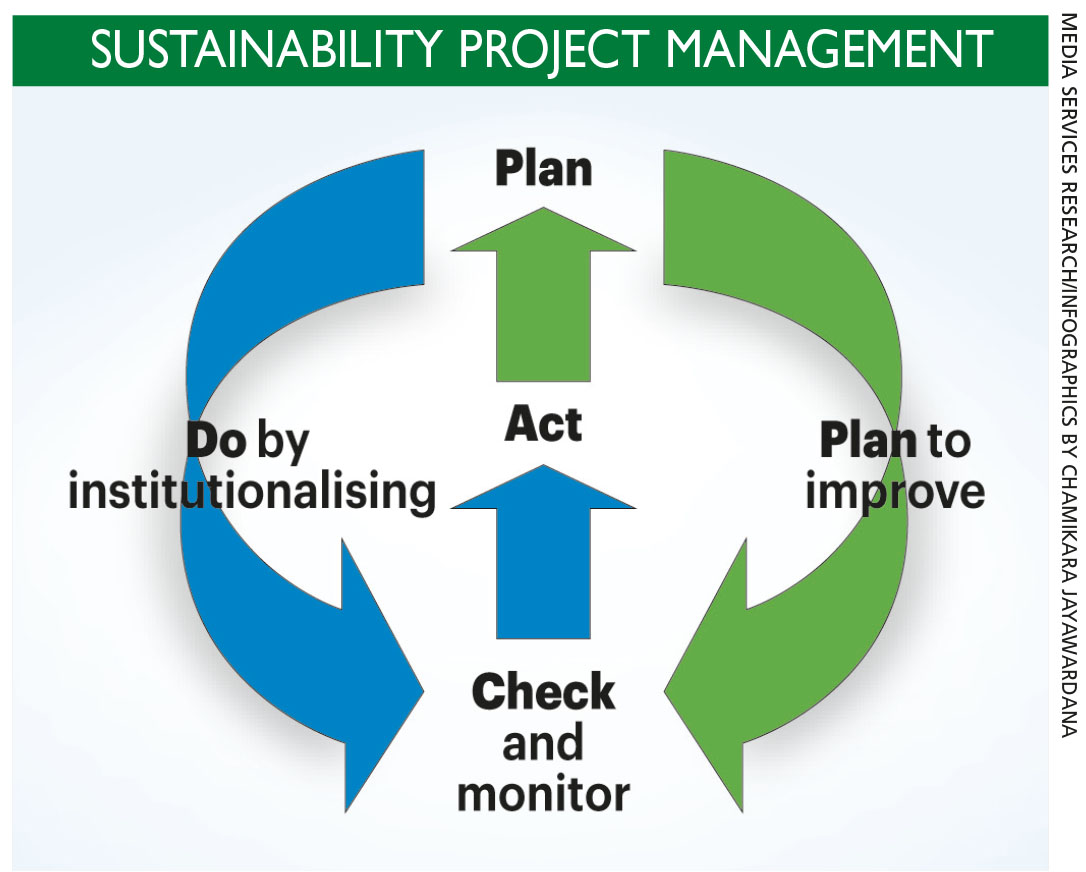PROJECT MANAGEMENT
SUSTAINABILITY JOURNEYS
Tools to help a biz achieve its goals – Kiran Dhanapala

While an organisation’s sustainability journey is more than merely a collection of projects, they are valuable tools that can help an enterprise achieve its sustainability goals. These projects can be individual, departmental, organisational or those that are undertaken in collaboration with external stakeholders.
A call for project ideas is best designed in-house with an element of competition and teamwork, to move things along in a fun and dynamic way.
However, projects on their own don’t make an organisation sustainable or achieve its sustainability goals. There needs to be a sustainability management system that integrates everything, and enables an enterprise to maintain the momentum and incorporate lessons learned on its sustainability journey.
This sustainability management system provides a way to check if projects are working, what lessons have been learnt, how to use these in future initiatives and a way to prioritise the most important ideas.
There is a business case for every project – i.e. a justification or reasoning for the proposed action. While the financial or commercial element is a key factor in a business scenario, it also includes social and environmental outcomes.
Your guide to making decisions is a sustainability strategy with its goals and targets, as well as key performance indicators (KPIs) etc. The UN’s Sustainable Development Goals (SDGs) provide a more detailed guide for your project path through their respective targets and indicators.
There are several components that need to be incorporated for a viable sustainability project.
First, planning is vital in identifying strategic projects that expand your organisational sphere of influence beyond its existing boundaries. It includes projects that cut your negative impacts and help you contribute positively. Prioritising projects is also important and requires the development of strong criteria.
It is necessary to include financial criteria by assessing the costs and benefits of different projects including other nonfinancial conditions. So ask for calculations of ROI, what costs and benefits have been included, how they were valued and so on.
Projects offer short-term ROIs that offset the increased cost of equipment and capital among others. As time goes on however, it is common to increasingly exhaust the low hanging fruit or easier and cheaper to undertake sustainability project initiatives. Therefore, financial criteria will need to be modified as you go along.
An organisational culture that promotes inclusiveness, innovation and collaboration will elicit the best project ideas. This promotes innovative thinking and contributions from every stratum of a company.
Businesses can achieve better results by using a portfolio approach.
This includes bundling short and longer payback periods (or blended payback of a portfolio of projects at a single site, region, branch or even across operations) to ensure that initiatives that are necessary – but longer term and more expensive – can still be implemented. This will unlock far deeper carbon savings as well as cost reductions.
Secondly, strong project implementation and operational tools are needed.
This includes training staff wherever necessary and also rewriting job descriptions, and creating a mix of incentives for staff to participate in projects. Communication is key as is the integration of sustainability projects into the usual departmental and business operations – such as human resources, marketing and procurement.
Collaboration is another important facet; it addresses the involvement of stakeholders and technical partners in projects. Send ‘sustainability champions’ to participate in projects with external stakeholders by sharing staff skills and time on expeditions or initiatives to assist a partner’s projects.
Partnerships that are diverse will yield interesting benefits and dividends, such as Marks & Spencer and Oxfam.
To be effective, partnerships need to have a clear understanding of the system and scope of interest or project boundaries so that they complement rather than compete with each other. There also needs to be awareness of the differences in size, capacity and power between partners – particularly big businesses and local authorities or NGOs.
Projects must be monitored efficiently to ensure their smooth implementation and achievement of results or impacts carefully calculated. This is often the weakest area and yet, the most important for the demonstration of various impacts that have been sustained as planned.
This includes normal tracking, identifying relevant sustainability metrics, obtaining baseline information before the project commences, and the regular collection of data and metrics to demonstrate impact.
Carry out project reviews during implementation and after each project hits various milestones or ends. This is needed to facilitate learning lessons gained from the project and sharing them within the business.
Reviews can be quarterly or annual and part of run-of-the-mill management activities. They must include metrics, objectives, audit results, challenges and new priorities. The process should end with documented results and recommendations, and be published in an annual report or another publication.
In Sri Lanka, sustainability projects are increasing with an interesting variety and diversity of topics and content, and standards have been gradually rising. Common areas that need strengthening include the greater use of KPIs, sustainability metrics, monitoring of impact and conducting independent evaluations to assess the impact.



